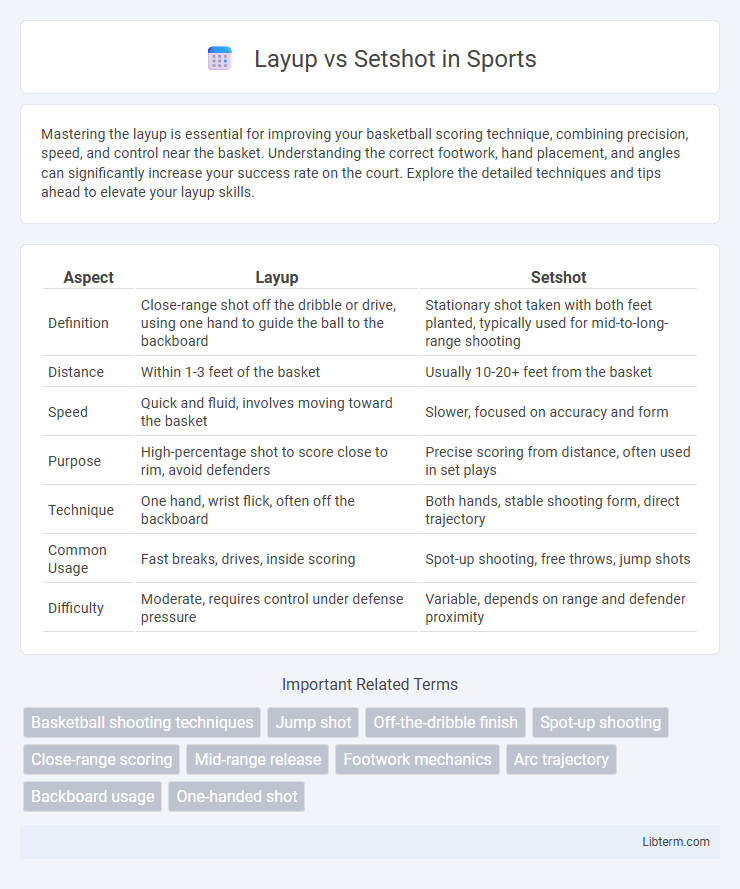Mastering the layup is essential for improving your basketball scoring technique, combining precision, speed, and control near the basket. Understanding the correct footwork, hand placement, and angles can significantly increase your success rate on the court. Explore the detailed techniques and tips ahead to elevate your layup skills.
Table of Comparison
| Aspect | Layup | Setshot |
|---|---|---|
| Definition | Close-range shot off the dribble or drive, using one hand to guide the ball to the backboard | Stationary shot taken with both feet planted, typically used for mid-to-long-range shooting |
| Distance | Within 1-3 feet of the basket | Usually 10-20+ feet from the basket |
| Speed | Quick and fluid, involves moving toward the basket | Slower, focused on accuracy and form |
| Purpose | High-percentage shot to score close to rim, avoid defenders | Precise scoring from distance, often used in set plays |
| Technique | One hand, wrist flick, often off the backboard | Both hands, stable shooting form, direct trajectory |
| Common Usage | Fast breaks, drives, inside scoring | Spot-up shooting, free throws, jump shots |
| Difficulty | Moderate, requires control under defense pressure | Variable, depends on range and defender proximity |
Introduction to Layup and Set Shot
A layup is a close-range basketball shot taken by driving toward the basket and gently laying the ball off the backboard or directly into the hoop, typically executed while moving. A set shot, conversely, is a stationary jump shot taken from a fixed position without dribbling, relying heavily on proper foot placement and shooting form. Understanding the fundamentals of both layups and set shots is essential for improving scoring versatility and game efficiency.
Key Differences Between Layup and Set Shot
Layups involve close-range shots taken while moving toward the basket, emphasizing speed and agility, whereas set shots are stationary shots typically taken from mid- to long-range positions. Layups rely on quick footwork and body control to avoid defenders and score in the paint, while set shots depend on precise shooting mechanics and balance to ensure accuracy. The key difference lies in motion and proximity: layups are dynamic and near the hoop, set shots are static and farther away.
Mechanics of a Layup
The mechanics of a layup involve precise footwork, body control, and hand placement to execute an effective close-range shot. Proper alignment starts with a strong approach step, driving off the inside foot while extending the shooting arm smoothly toward the backboard's square. Utilizing backspin and maintaining focus on soft touch mechanics maximizes scoring efficiency by reducing the chance of missed shots or offensive rebounds.
Mechanics of a Set Shot
The mechanics of a set shot emphasize a stable, balanced stance with feet shoulder-width apart, knees slightly bent to generate power from the legs. The shooter focuses on proper hand placement, with the shooting hand under the ball and the guide hand on the side, ensuring a smooth release and follow-through for accuracy. Executing a set shot requires consistent alignment of the elbow, wrist snap, and focused eye contact on the target to maintain precision and control.
Situations Best Suited for Layups
Layups are best suited for close-range scoring opportunities, typically when a player is driving toward the basket with minimal defensive obstruction. This shot excels in fast-break situations or when defenders are out of position, allowing for high-percentage scoring near the rim. Players use layups to exploit gaps in the defense, maximizing scoring efficiency in crowded paint areas.
Situations Best Suited for Set Shots
Set shots are ideal in basketball when players have ample time and space to establish proper shooting mechanics, such as during free throws or after a team has reset their offense. These shots are preferred in mid-range or three-point attempts where accuracy is critical and defenders are positioned further away, enabling a controlled release. Unlike layups that require quick decisions and close proximity to the basket, set shots maximize precision in well-lit shooting situations with minimal defensive disruption.
Advantages and Disadvantages of Layups
Layups offer high shooting accuracy due to their proximity to the basket, making them one of the most efficient scoring methods in basketball, especially during fast breaks. However, layups can be easily contested by defenders who anticipate the close-range attempt, increasing the risk of blocked shots or forced misses. The technique requires strong body control and timing to avoid fouls and maintain scoring opportunities under pressure.
Advantages and Disadvantages of Set Shots
Set shots offer precision and stability due to their stationary nature, making them ideal for accuracy from mid-range or beyond the three-point line. The main disadvantage is the lack of defensive evasion since the shooter is stationary, increasing the likelihood of being blocked or contested. Set shots also require good footwork and balance to maintain consistency under pressure.
Tips to Master Layups and Set Shots
Mastering layups requires focusing on proper footwork, using the backboard effectively, and maintaining a soft touch to ensure accuracy near the basket. For set shots, emphasizing a consistent shooting form, balanced stance, and steady follow-through helps improve precision from mid-range distances. Practicing these techniques regularly enhances muscle memory, leading to more reliable scoring opportunities in game situations.
Choosing the Right Shot in Game Scenarios
Choosing the right shot in basketball depends on game scenarios such as player positioning and defensive pressure. A layup offers high-percentage scoring close to the basket, ideal in fast breaks or when the defender's positioning allows for a clear path. In contrast, a set shot is effective for mid-range or long-range attempts where stability and accuracy are prioritized, especially when defenders are positioned to contest drives to the basket.
Layup Infographic

 libterm.com
libterm.com